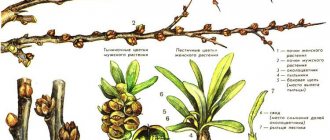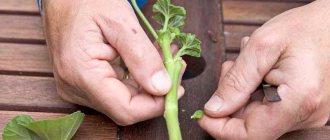Landing rules
At first glance, the tenacious, powerful branches of deciduous shrubs give the impression of the plant’s high endurance and its adaptability to any conditions. However, gardeners often admit to the unprofitable results of planting wild roses in saline and marshy areas. Also, rocky, clayey and sandy loam substrates with a high lime content are not recommended for rooting the crop. Experts consider fertile, moderately moist chernozems with a thick arable layer and neutral acidity to be ideal for growing varietal rose hips.
The area should be well lit, so elevated areas are preferred, protected from draft winds, accumulation of cold air, as well as melt and rain water. A feature of the shrub is a highly developed tap root system, the shoots of which reach a depth of 5-6 m. At the same time, the main part of the roots deepens only 15–40 cm from the surface of the earth, occupying a wide circle near the trunk, with a radius of up to 1 m. Some species tend to grow voluminous underground caudexes, which are the source of innumerable lignified root shoots.
Important! Experienced raw material producers distinguish wild rose bushes by the amount of nutrients they contain. The best ones are those in which the sepals stick out upward, and the berries have a round hole under the calyx. The low-vitamin type is determined by
its downward-pointing leaves, which form a dense pentagon underneath.
In turn, these adventitious shoots form highly branched turions, which form new rose seedlings. Visually, such a rose hip grows strongly at the expense of neighboring offspring and forms dense thickets. The plant may die from excess moisture, so when choosing a planting location, you should take into account the occurrence of underground currents. Some homeowners recommend planting rose hips near utility buildings or on the border of their yard, moving away from dusty roads and industrial zones.
After all, the plant is famous for its beneficial properties, as well as its ability to absorb toxic substances from the environment. Experienced gardeners advise everyone who wants to grow this crop to protect its tree trunk circle with a moat up to 20 cm deep. It will stop the roots from spreading across the area. To make the proposed method more aesthetically pleasing, any decorative fencing that fits into the overall design of the garden can be deepened to this level. In order for the bushes to bear fruit well, it is recommended to place several seedlings of different types and varieties nearby. Identical crops are allowed only when propagated using seeds.
Did you know? Ancient Greek legends associate the bright red color of rose hips with the blood of Aphrodite, who ran headlong to the place of her lover’s death, knocking her legs until they bled and not even noticing how the thorny wild roses were tearing her body.
In order for the plant to take root well in the future and produce a bountiful harvest, it is important to adhere to the following rules:
- Young bushes with strong roots that are at least 2 years old are best suited for planting.
- Regardless of how you plan to arrange the bushes (clumps or rows), be sure to leave gaps of one and a half meters between adjacent plants.
- If you plan to root in the spring, soil fertilizing is required in the fall. To do this, in the second ten days of October, plowing the area, add compost or rotted humus (6-7 kg per 1 m²) to a depth of 30 cm. When planting seedlings in autumn, fertilizer should be applied at least 4 weeks earlier.
- Planting rose hips requires a square hole, up to 30 cm deep. In the absence of timely preparation of the soil and fertilizer, it is recommended to make the hole deeper and wider (80x50 cm). Drainage and abundant watering are important (you will need at least 8 buckets of settled water warmed to room temperature).
- At the final stage, it would be a good idea to mulch the wet soil in the tree trunk circles with peat chips. Make sure that in summer the thickness of the mulch layer does not exceed 3 cm, otherwise the roots will begin to rot.
Video: planting rose hips
Reproduction methods at home
All types of rose hips are very tenacious. Their cultivation will not create difficulties even for novice gardeners. Moreover, all methods of propagation are available: by grafting, green cuttings, dividing a bush, growing a new seedling from grains or root cuttings.
Did you know? The oldest rose hip bush was discovered near a temple in the German city of Hildesheim. Its branches stretch up to 13 m in height, and the girth of the trunk reaches half a meter. It is assumed that the age of the giant is about a thousand years.
Cuttings
This method is considered the simplest and most accessible. Its advantage also lies in the high survival rate of the cuttings used. To obtain young seedlings, it is necessary to make biological preparations at the end of June, when the shoots begin to become lignified. They are apical branches, 7–10 cm long with an oblique cut and 3–4 cm internodes. When cutting a cutting, leave about 1 cm above the leaf node. Also, be sure to remove the lower leaf plate, and shorten all large foliage by a third.
Propagation of rose hips by cuttings: 1 - cutting cuttings; 2 - cuttings at the time of planting; 3 - cuttings 4 weeks after rooting; 4 - new plant. Most owners prefer to grow roots in water with any growth stimulant. To do this, dilute either “Ecosil”, “Emistim”, “Heteroauxin” in a glass or other glass container according to the recommendations and leave the cut shoots in the resulting liquid so that their base is immersed by 5-6 cm. The vessel can be removed in a well-lit, warm place, waiting for roots to appear in the water.
Do not forget to monitor the freshness of the liquid, since in the heat there is a high risk of pathogenic microflora forming in it. Refresh the solution as necessary. The appearance of thin thread-like processes at the cut site is a sign of a successful experiment. Such a workpiece can be planted in the ground. Experienced gardeners recommend initially rooting the seedling in a peat pot, and after its root system has become stronger, transplanting it to a permanent place.
If you are confident in the potential of the formed rhizome, you can immediately place it outside. It is better to take cuttings from bushes that have been fertilized with nitrogen, phosphorus and potassium, as well as those that are pruned in a timely manner. You should not harvest planting material from wild and unkempt plants. They reproduce easily, but the risks of fungal, bacterial and viral infection are high. In addition, without proper care, rosehip adapts to conditions of constant survival and, as a result, produces few fruits of low quality.
Important! When planting wild rose cuttings outside, leave a distance of about half a meter between them, since by autumn, due to the growth that appears, the bushes will begin to shade each other. In the future they will need to be planted.
Seeds
Not everyone dares to propagate rose hips by seed. The vast majority of breeders prefer such experiments. They noted that as a result of the work carried out, the varietal characteristics of the mother plants were not preserved. The grown seedlings differ significantly in the shape of the foliage, the height of the shoots, and the number of spines and berries. At the same time, their rich chemical composition is not lost.
The first step to implement the idea is to prepare planting material. This work should be planned in August, when the skin of the fruits turns red, but they have not yet reached their ripeness. When you cut the achene, you will see coarse fibers and numerous single-seeded nuts of various shapes and shapes. Their germination persists for 2 years. Remove the grains, rub through a sieve and rinse with water.
After these manipulations, the seeds can be immersed in moist soil to a depth of 2-3 cm, keeping intervals of 1-2 cm. But it is better to plan sowing in mid-autumn, when the earth has not yet cooled down and autumn frosts have not begun. It is advisable to water the sown bed generously and mulch it with sawdust so that emerging weeds do not choke out the seedlings, and also so that the grains successfully overwinter. Despite the large embryo in the seeds, they are difficult to germinate. This is due to poor water permeability of the fruit shell.
The first shoots at the sowing site will appear only in the spring of next year. Be prepared for the fact that they can easily be confused with weeds. Therefore, it is recommended to sow in school. A film cover will accelerate the development of young shoots, under which it is necessary to build a special frame above the planting in advance. When the first pair of leaves is formed on the seedlings, the rose hips need to be transplanted to a permanent plot, retreating 10 cm from each seedling.
Important! Large berries with protruding sepals are recommended for drying. If their edges are pressed tightly against the peel, the harvest began too early - the rose hips need time to ripen better.
If it is necessary to postpone sowing, the collected grains should be carefully prepared:
- First, dry them in natural conditions, then combine them with a peat-sand mixture. It is advisable to cook it in a container with high sides in a ratio of 1:4.
- Place the covered vessel in the refrigerator and store it this way until January-February. After stratification, germination will increase. During storage, stir the planting material periodically.
- In the middle of winter, move the grains indoors. Closer to March, they will begin to hatch, after which they can be transferred to the garden.
- The process of spring planting differs from autumn only in the need to make a larger depression (up to 4 cm) for sprouted seeds, as well as increased accuracy. The sprouts do not need to be covered with soil. It is necessary to wait for rooting, after which the row should be mulched.
Dividing the bush
This method is especially popular because it does not require special knowledge and skills. Bushes aged 5-6 years are best suited for it. Reproduction is carried out by transplanting bushes. After digging, their root system is divided into 3-4 parts. It is important that at least 2 sprouts remain on each of them.
Disembarkation time
If the seeds were collected in August, then after stratification they can be planted in a box with soil and left in the basement. By spring they will rise together. However, there are times when seedlings do not appear in the spring. Then you should not rush to throw away the soil along with the seeds. Some rosehip varieties germinate only the following spring. Therefore, you can wait another year, and the next year you can see the sprouted seeds.
You can also plant seeds directly in open ground in August. To do this, you need to select them from rose hips and immediately plant them in the ground to a depth of 2 centimeters. Sprinkle the top with wet sawdust, which will maintain the required soil moisture. After lying in the ground for the winter, the seeds will undergo natural stratification; by spring, some of them will sprout. To make it easier to weed them later and loosen the soil, you need to make holes from each other at the distance of a hoe
You can also plant the seeds in early spring.
To do this, seeds are selected from unripe fruits, washed and dried. Then they need to be packaged in a dry jar and left in the refrigerator until February. After this, they are poured into calcined sand, which then needs to be moistened. Place this mixture in a bag and refrigerate for 2 months until April. To maintain the required moisture content in the bag, you can add water little by little. By the end of the second month in the refrigerator, the rosehip seeds will begin to hatch.
Ready sprouted seeds need to be planted in open ground. To do this, a groove is made 3 centimeters deep, and the seeds are carefully placed in it. You need to sprinkle wet sawdust on top of them. Soil is not recommended as it can break the sprouts very easily.
Rose hip care
In order for a wild rose to quickly adapt to new conditions and fully develop, it is necessary to provide competent care from the first days.
It consists in:
- Moderate periodic watering . The plant tolerates prolonged heat and drought well. Therefore, adult bushes do not require frequent moistening, which cannot be said about young seedlings. In hot weather, they need to be watered regularly (each bush requires no more than 2 buckets of water). Fruit-bearing roses also need increased attention. It is recommended to pour about 5 buckets under them. During the season, it is advisable to carry out 3-4 soil moistenings. Don't forget to loosen the soil in the garden and cover it with mulch.
- Timely feeding . They are relevant only for young bushes at the beginning of the growing season, in spring, during the period of fruit ripening and after they are removed from the branches. It is better to add chicken manure diluted in a ratio of 1:50. From the second year of life, the bushes do not require special care. It is advisable to feed them every 3 years.
- Regular anti-aging pruning . The fact is that all Rosaceae have a tendency to partially lose shoots as a result of drying out. This process occurs periodically every 4-5 years. Rosehip pruning is carried out in the spring in the first year of life, removing all branches on the seedling. Shoots 5–10 cm high are left on the seedling. In the future, it will be necessary to thin out the crown every 3 years. In order to increase the yield, immediately form it from 15 shoots. At the same time, make sure that the branches are of different years and it is advisable that among them there are no specimens that are more than 7 years old.
Experts strongly recommend pruning in the spring. In their opinion, the bushes are severely damaged when unnecessary shoots are removed and, in the case of autumn pruning, will not be able to survive the winter safely. Please note that thoughtless shortening of branches will not improve the yield of the bush, but will only provoke intensive growth next spring. As a result, the wild rose, not having time to complete the process of forming young shoots, will stop bearing fruit.
Did you know? Rose hips contain 50 times more ascorbic acid than lemons.
How to grow rose hips at home, from seeds - sowing features
The option of growing rose hips from seeds is considered the simplest and does not require much power. But it is worth noting that this option has its own nuances, which can be classified as disadvantages.
The sprouts emerging from the planted rosehip seeds can be observed no earlier than twelve to eighteen months later.
Gardeners with extensive experience advise collecting fruits that have not reached full maturity to obtain seed material. Germinating seeds from such fruits will give the best possible results.
Fruits should be collected for seed material immediately after their color turns red.
Reproduction of rose hips in nature
Modern botanists are still debating the number of calculated rosehip species. There are about half a thousand of them, and there are more than 25 thousand varieties of this crop. Despite belonging to a common genus, all plant species are individual. It’s easy to judge this by comparing the common wild rose in our area and, for example, in France. The crop, growing in tropical forests, adapted to the constant lack of sun and, as a result of evolution, gradually turned into a liana.
Therefore, you will not see drooping or upright shrubs in the French provinces. The local rosehip has flexible long branches that are woven into the crowns of trees to reach the desired light. Its propagation usually occurs by seed. Wind-blown grains are perfectly preserved even in water. Most species of rose hips in the wild are dense, thorny thickets formed through vegetative propagation.
Some young seedlings emerge from the root shoots, gradually separating from the mother bush. Thus, taking into account the characteristics of the root system of a wild rose, self-renewal of its bushes occurs. An example of this would be the largest rose hip bush on the planet. It now grows in the United States of America. It is less than 200 years old, but its luxurious branches spread over an area of over 740 m². During flowering, the wild bush is covered with 200 thousand delicate buds, exuding an indescribable aroma.
Find out how to replant a mature rosehip bush.
Rosehip is a unique natural heritage inherited from ancient ancestors. Behind its prickly thorns hides delicate fragrant blooms and an abundance of vitamins and berries. In the warm season, a cultivated bush is pleasant to look at because of its decorative effect, and in the cold season it will reward you with a useful harvest. And to have more of it, you need to put in a little effort, care and love.
Stratification process
Stratification includes sufficient moisture of the seeds and their further cooling. Why is this necessary? Rosehip seeds have a hard shell, making germination more difficult. In order for the sprout to break through the shell faster and easier, it needs to be destroyed a little. Moisture and cold contribute to this.
After washing the seeds, they need to be mixed with wet sand in a 1:1 ratio. Now they need to be packed in a tight bag and put in the refrigerator for two months.
During this time, the hard shell of the seeds will become softer and by then it will be possible to plant them in the soil.











